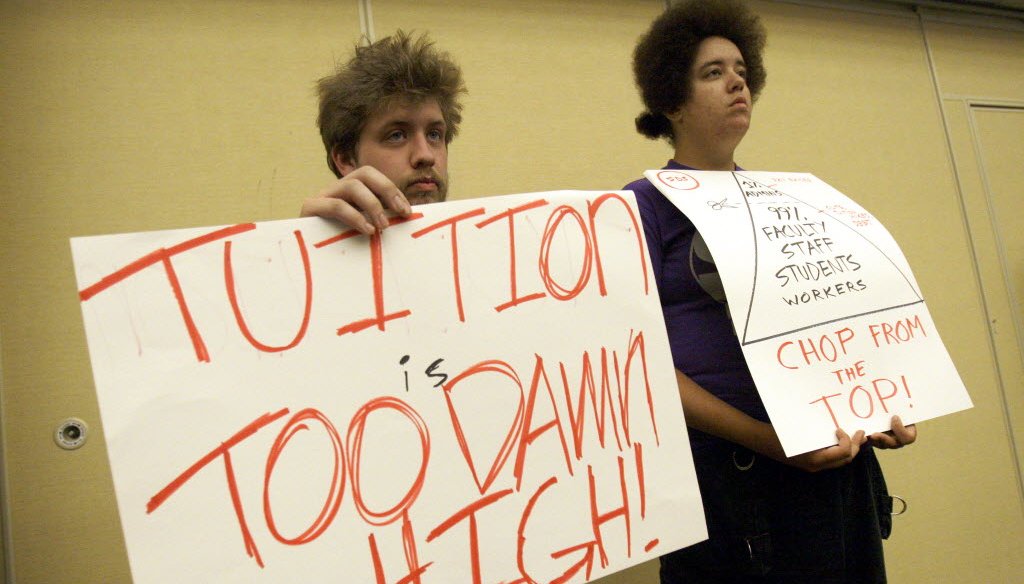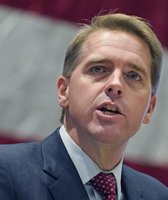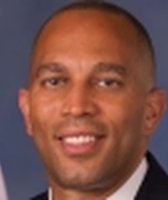Stand up for the facts!
Our only agenda is to publish the truth so you can be an informed participant in democracy.
We need your help.
I would like to contribute

Students at the University of Wisconsin-Milwaukee protested tuition hikes in June 2012. UWM is part of the UW System, which is being criticized for accumulating cash reserves while raising tuition rates.
The amount of excess cash in the University of Wisconsin System’s bank account is:
A) "Nearly $1 billion"
B) $648 million
C) $207 million
Hmmm; the difference between A and C seems about as large as, well, A to Z.
Sign up for PolitiFact texts
Yet all three figures -- often with the term "slush fund" -- have been cited since an April 19, 2013 report revealed that the UW System has amassed a significant cash surplus.
So, just how large is the surplus?
And how does it compare to what the system would lose if a planned state funding increase is pulled back? Or to the amount of tuition increases over the past few years?
There are different ways to characterize how much extra money the UW System has. So, we’ll set aside the Truth-O-Meter in favor of trying to give context to the various numbers being tossed about.
You’ve just enrolled in Surplus 101.
Lay of the land
The UW System serves more than 181,000 students at 13 two-year colleges and 13 four-year universities, including the flagship University of Wisconsin-Madison.
Its annual budget is big -- $5.6 billion, the same amount of revenue Harley-Davidson earned in 2012.
So, it's no surprise the UW System would keep some extra cash in its kitty. But how much?
-
After news of the surplus hit, conservative Milwaukee talk show host Jay Weber declared that the UW System has "a nearly $1 billion reserve fund."
-
State Rep. Steve Nass, R-Whitewater -- who called system officials "educational crooks" and "con artists" -- bemoaned a "$648 million surplus."
-
And Tim Higgins, a member of the Board of Regents, the UW System's governing body, said only $207 million of the "slush fund" (his words) isn’t already committed to certain uses.
So, let’s break down the numbers, relying on the report on the surplus, which was done by the nonpartisan Legislative Fiscal Bureau at the request of state lawmakers. The amounts refer to balances as of June 30, 2012, the end of the most recent fiscal year.
Surplus figures
$1 billion -- That’s the amount of "program revenue appropriations" the UW System had on hand. Let’s call it the total surplus.
It’s 25 percent higher than it was a year earlier.
The largest portion of the $1 billion -- $414 million, or nearly 40 percent of the total surplus -- came from tuition. Federal aid and gifts were among the other sources of cash.
$648 million -- That’s the amount left if you subtract from the $1 billion money that came with strings attached -- gifts, grants, federal aid and other funds. Call it the unrestricted surplus.
The fiscal bureau said it’s reasonable to make those subtractions because the UW System must spend federal aid based on federal rules. Similarly, gifts and grants – like a donation to fund a particular researcher -- are typically provided for specific purposes.
$207 million -- That’s what’s left if you subtract $441 million from the $648 million unrestricted surplus. The UW System says $441 million is being held in reserve for specific activities in the future. One proposal is for up to $30 million in additional student financial aid during 2013-2015.
The fiscal bureau’s report doesn’t list the future activities; and it notes that the UW System did not identify the timing for those future expenditures.
But it means only $207 million isn’t designated for some purpose. We’ll call it the leftover surplus.
So, we can see why there is a wide range in what various folks identify as the UW System’s surplus, or "slush fund," which system president Kevin Reilly has defended as being in line with or below what similar university systems have across the country.
But whether we’re talking about $1 billion or $207 million, the amounts can be difficult to grasp. So let’s give them some perspective.
Making comparisons
The one figure people seem to agree on is $648 million, the unrestricted surplus.
Nass, who is chairman of the Assembly Colleges and Universities Committee, contends the $648 million represents one-fourth of the UW System’s budget. And the fiscal bureau report backs him up, with a caveat.
As we noted, the system’s entire budget is $5.6 billion. The $648 million surplus represents a fourth of the budget only if you consider the smaller, unrestricted portion of the system’s entire budget, which is $2.5 billion.
Higgins, the UW regent, also cherry picks figures, but in a different way, when he claims the "slush fund" is only 3 percent of the system’s budget.
If you divide $207 million leftover surplus by the system’s entire budget of $5.6 billion, you get 3.7 percent, slightly higher than what Higgins claimed.
Before we close, a couple of other comparisons.
Proposed budget increase: Gov. Scott Walker proposed a $181 million in state tax support for the UW System in his 2013-15 state budget, which is now being considered by the Legislature. Several Republican lawmakers have said the $181 million should be eliminated, but Walker said he would keep it in his budget.
The $181 million amounts to about one-fourth of the $648 million unrestricted surplus.
Tuition: As we noted, of the $1 billion total surplus, $414 million came from tuition. That figure is up from $212.8 million in tuition money that was on hand three years earlier, at the end of fiscal 2009.
Despite the excess tuition money on hand, the UW System raised tuition by 5.5 percent in each of the past six years, generating about $35 million per year. Now Walker and other GOP leaders are calling for a two-year tuition freeze, which could cost the system $28 million it has been expecting.
The fiscal bureau report noted that state aid to the UW System was reduced significantly over the past three years. Indeed, the reduction in fiscal 2012 alone was $173 million, according to the UW System’s latest annual financial report.
Going forward
The fiscal bureau concluded its report by saying "there are important policy questions raised" by the surplus, including:
"What is the appropriate level of UW System appropriation balances?
"What role, if any, should the Legislature have in determining the appropriate level, and use of, UW System appropriation balances?
"To what extent should the Board of Regents be permitted to charge current students tuition to fund programs that will benefit future students?"
Stay tuned. As the state budget debate continues, we may all have to enroll in Surplus 102.
Our Sources
Wisconsin Legislative Fiscal Bureau, memo, April 19, 2013
University of Wisconsin System, news release, April 19, 2013
University of Wisconsin System, statement, April 19, 2013
University of Wisconsin System, 2012 annual financial report
Interview, University of Wisconsin System spokesman, April 23, 2013
Milwaukee Journal Sentinel, "Scott Walker, GOP lawmakers urge 2-year UW tuition freeze," April 19, 2013
Milwaukee Journal Sentinel, "Outrage grows as University of Wisconsin System admits it ‘did not draw attention’ to cash," April 22, 2013






































